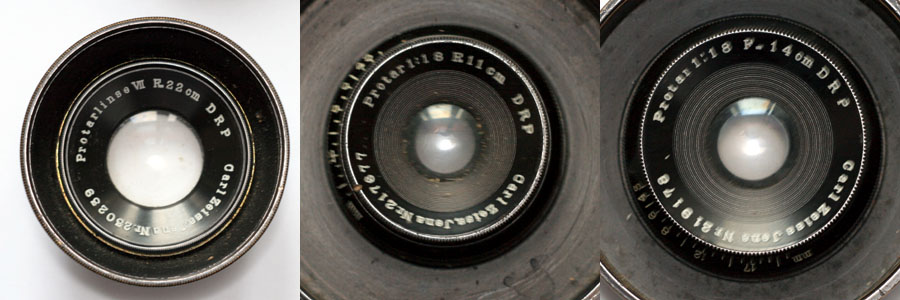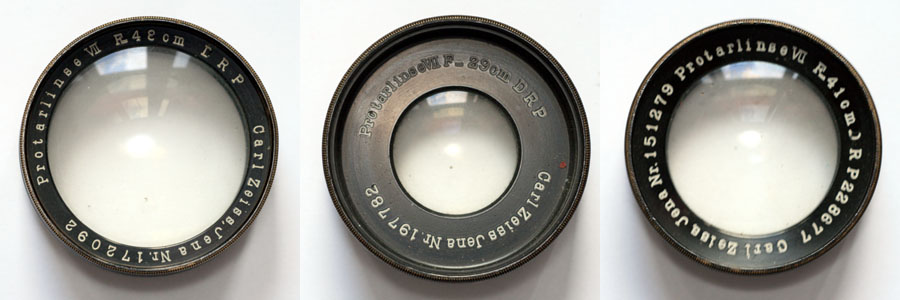| View previous topic :: View next topic |
| Author |
Message |
MF-addicted


Joined: 11 Mar 2009
Posts: 803
Location: Stuttgart (Germany)
|
 Posted: Fri May 22, 2009 11:23 am Post subject: 1911-1913 Zeiss Protar Set for LF Posted: Fri May 22, 2009 11:23 am Post subject: 1911-1913 Zeiss Protar Set for LF |
 |
|
MF-addicted wrote:
Just got a collection of some brass Zeiss Jena PROTAR lens.
Does anybody know these lenses.
Any experiences ?
Sorry for some shaky pictures - recognized it too late.
Seems to be around 1911-1913 according the following link:
http://www.earlyphotography.co.uk/site/serial3.html


_________________
EOS 5D MK II, EOS 5D Classic, EOS 400D --------------------------------------------------------------------------------------------------------------------------------
Canon FD to EOS converted: FD 1,4/24 asph, FD 2,8/300 L
Carl Zeiss Jena:Pancolar 2/50, black Biotar 2/5,8cm 17bl., slim Biotar 1,5/7,5cm 18bl., Pancolar 1,8/80mm, Sonnar 3,5/135, Triotar 4/135
Carl Zeiss: Distagon 4/18T*, Distagon 1,4/35 HFT, Planar 1,4/50 T*, Vario-Sonnar 3,4/35-70 T*,Vario-Sonnar 4,5-5,6/100-300 T*
Leitz: Elmarit-R 2.8/28 E55 II, Summicron-R 35 I, Elmarit-R Wetzlar 2.8/35 E55 II, Summicron-R 2/50 Wetzlar I, Macro Elmarit-R 2.8/60 I, Summicron-R 2/90 E55 I, Elmarit-R 2,8/90 I, Elmarit-R Wetzlar 2,8/135 I, Elmarit-R 2.8/180 Wetzlar E67 II, Vario Elmar 4/70-210 E60, MR Telyt-R 8/500
Schneider: Xenar 2.8/50
Russian: Industar 50-2, Industar 61,Helios-44-1 2/58mm,Helios-44-2 2/58mm, MC 3M-5CA 8/500
Meyer: Pentacon 3,5/30, Domiplan 2,8/50, Trioplan 2,9/50, Trioplan 3,5/75, Trioplan 2,8/100, Orestor 2,8/135mm, Orestegon 4/200
ISCO: Westron 2,8/35, Westron 3,5/35, Tele-Westanar 3,5/135, Tele-Westanar 4/180
Yashica: ML 15, ML 21, ML 24, ML 28, ML 35, ML 100/3.5 Macro,
Nikon: Nikkor AI 2,0/24, Nikkor AIS 2,0/28, Nikkor Ai 1,8/50, Nikkor-P (Sonnar) 2,5/105 silver, Nikkor-P (Gauss) 2,5/105 black
Steinheil Cassar 3,5-4,5/75 VL, Quinar 3,5/85, Culminar 4,5/105, Culminar 4,5/135, Auto-D Tele Quinar 2,8/135
Tomioka Tomioka - Cosinon 1,2/55, Tomioka - Revuenon 1,4/55
Voigtländer: Septon 2/50
Others: Officine Galileo Ingra 3,5/5cm, Wilon 4,5/75, Dallmeyer 4,5/4", Bonotar 4,5/105,
Lenses for sale, please contact via PM: None at the moment
|
|
| Back to top |
|
 |
Orio

Joined: 24 Feb 2007
Posts: 29545
Location: West Emilia
Expire: 2012-12-04
|
 Posted: Fri May 22, 2009 1:09 pm Post subject: Re: 1911-1913 Zeiss Protar Set for LF Posted: Fri May 22, 2009 1:09 pm Post subject: Re: 1911-1913 Zeiss Protar Set for LF |
 |
|
Orio wrote:
| MF-addicted wrote: |
Does anybody know these lenses.
|
Yes, Protar is another name for Doppel Anastigmat.
Zeiss invented the name Anastigmat but did not copyright it. So other companies started using it.
Protar is the later registered name for the Zeiss anastigmat.
It is one of the earliest Zeiss lenses.
It will be interesting to see your samples when you post them.
_________________
Orio, Administrator
T*
NE CEDE MALIS AUDENTIOR ITO
Ferrania film is reborn! http://www.filmferrania.it/
Support the Ornano film chemicals company and help them survive!
http://forum.mflenses.com/ornano-chemical-products-t55525.html |
|
| Back to top |
|
 |
MF-addicted


Joined: 11 Mar 2009
Posts: 803
Location: Stuttgart (Germany)
|
 Posted: Fri May 22, 2009 1:19 pm Post subject: Posted: Fri May 22, 2009 1:19 pm Post subject: |
 |
|
MF-addicted wrote:
I will have to buy a M42 body cap and modify it to a bellow.

_________________
EOS 5D MK II, EOS 5D Classic, EOS 400D --------------------------------------------------------------------------------------------------------------------------------
Canon FD to EOS converted: FD 1,4/24 asph, FD 2,8/300 L
Carl Zeiss Jena:Pancolar 2/50, black Biotar 2/5,8cm 17bl., slim Biotar 1,5/7,5cm 18bl., Pancolar 1,8/80mm, Sonnar 3,5/135, Triotar 4/135
Carl Zeiss: Distagon 4/18T*, Distagon 1,4/35 HFT, Planar 1,4/50 T*, Vario-Sonnar 3,4/35-70 T*,Vario-Sonnar 4,5-5,6/100-300 T*
Leitz: Elmarit-R 2.8/28 E55 II, Summicron-R 35 I, Elmarit-R Wetzlar 2.8/35 E55 II, Summicron-R 2/50 Wetzlar I, Macro Elmarit-R 2.8/60 I, Summicron-R 2/90 E55 I, Elmarit-R 2,8/90 I, Elmarit-R Wetzlar 2,8/135 I, Elmarit-R 2.8/180 Wetzlar E67 II, Vario Elmar 4/70-210 E60, MR Telyt-R 8/500
Schneider: Xenar 2.8/50
Russian: Industar 50-2, Industar 61,Helios-44-1 2/58mm,Helios-44-2 2/58mm, MC 3M-5CA 8/500
Meyer: Pentacon 3,5/30, Domiplan 2,8/50, Trioplan 2,9/50, Trioplan 3,5/75, Trioplan 2,8/100, Orestor 2,8/135mm, Orestegon 4/200
ISCO: Westron 2,8/35, Westron 3,5/35, Tele-Westanar 3,5/135, Tele-Westanar 4/180
Yashica: ML 15, ML 21, ML 24, ML 28, ML 35, ML 100/3.5 Macro,
Nikon: Nikkor AI 2,0/24, Nikkor AIS 2,0/28, Nikkor Ai 1,8/50, Nikkor-P (Sonnar) 2,5/105 silver, Nikkor-P (Gauss) 2,5/105 black
Steinheil Cassar 3,5-4,5/75 VL, Quinar 3,5/85, Culminar 4,5/105, Culminar 4,5/135, Auto-D Tele Quinar 2,8/135
Tomioka Tomioka - Cosinon 1,2/55, Tomioka - Revuenon 1,4/55
Voigtländer: Septon 2/50
Others: Officine Galileo Ingra 3,5/5cm, Wilon 4,5/75, Dallmeyer 4,5/4", Bonotar 4,5/105,
Lenses for sale, please contact via PM: None at the moment
|
|
| Back to top |
|
 |
Nesster


Joined: 24 Apr 2008
Posts: 5883
Location: NJ, USA
Expire: 2014-02-20
|
 Posted: Fri May 22, 2009 2:14 pm Post subject: Posted: Fri May 22, 2009 2:14 pm Post subject: |
 |
|
Nesster wrote:
Depending on size and so on, if you have extension tubes you might be able to fit a lens inside one, then the tube to the bellows. I use window insulating tape as gasket and black tape to hold the lens on. Not the best way to fix things, but it's quick and reversible while trying things out.
_________________
-Jussi
Camera photos
Print Photographica
|
|
| Back to top |
|
 |
MF-addicted


Joined: 11 Mar 2009
Posts: 803
Location: Stuttgart (Germany)
|
 Posted: Fri May 22, 2009 2:23 pm Post subject: Posted: Fri May 22, 2009 2:23 pm Post subject: |
 |
|
MF-addicted wrote:
| Nesster wrote: |
| I use window insulating tape as gasket and black tape to hold the lens on. |
Thanks, I will get some and will test at least one lens (with lowest f) this weekend.
_________________
EOS 5D MK II, EOS 5D Classic, EOS 400D --------------------------------------------------------------------------------------------------------------------------------
Canon FD to EOS converted: FD 1,4/24 asph, FD 2,8/300 L
Carl Zeiss Jena:Pancolar 2/50, black Biotar 2/5,8cm 17bl., slim Biotar 1,5/7,5cm 18bl., Pancolar 1,8/80mm, Sonnar 3,5/135, Triotar 4/135
Carl Zeiss: Distagon 4/18T*, Distagon 1,4/35 HFT, Planar 1,4/50 T*, Vario-Sonnar 3,4/35-70 T*,Vario-Sonnar 4,5-5,6/100-300 T*
Leitz: Elmarit-R 2.8/28 E55 II, Summicron-R 35 I, Elmarit-R Wetzlar 2.8/35 E55 II, Summicron-R 2/50 Wetzlar I, Macro Elmarit-R 2.8/60 I, Summicron-R 2/90 E55 I, Elmarit-R 2,8/90 I, Elmarit-R Wetzlar 2,8/135 I, Elmarit-R 2.8/180 Wetzlar E67 II, Vario Elmar 4/70-210 E60, MR Telyt-R 8/500
Schneider: Xenar 2.8/50
Russian: Industar 50-2, Industar 61,Helios-44-1 2/58mm,Helios-44-2 2/58mm, MC 3M-5CA 8/500
Meyer: Pentacon 3,5/30, Domiplan 2,8/50, Trioplan 2,9/50, Trioplan 3,5/75, Trioplan 2,8/100, Orestor 2,8/135mm, Orestegon 4/200
ISCO: Westron 2,8/35, Westron 3,5/35, Tele-Westanar 3,5/135, Tele-Westanar 4/180
Yashica: ML 15, ML 21, ML 24, ML 28, ML 35, ML 100/3.5 Macro,
Nikon: Nikkor AI 2,0/24, Nikkor AIS 2,0/28, Nikkor Ai 1,8/50, Nikkor-P (Sonnar) 2,5/105 silver, Nikkor-P (Gauss) 2,5/105 black
Steinheil Cassar 3,5-4,5/75 VL, Quinar 3,5/85, Culminar 4,5/105, Culminar 4,5/135, Auto-D Tele Quinar 2,8/135
Tomioka Tomioka - Cosinon 1,2/55, Tomioka - Revuenon 1,4/55
Voigtländer: Septon 2/50
Others: Officine Galileo Ingra 3,5/5cm, Wilon 4,5/75, Dallmeyer 4,5/4", Bonotar 4,5/105,
Lenses for sale, please contact via PM: None at the moment
|
|
| Back to top |
|
 |
Seele

Joined: 17 Apr 2009
Posts: 741
Location: Sydney Australia
|
 Posted: Sat May 23, 2009 6:13 pm Post subject: Re: 1911-1913 Zeiss Protar Set for LF Posted: Sat May 23, 2009 6:13 pm Post subject: Re: 1911-1913 Zeiss Protar Set for LF |
 |
|
Seele wrote:
| Orio wrote: |
Yes, Protar is another name for Doppel Anastigmat.
Zeiss invented the name Anastigmat but did not copyright it. So other companies started using it.
Protar is the later registered name for the Zeiss anastigmat.
It is one of the earliest Zeiss lenses.
It will be interesting to see your samples when you post them. |
Orio,
It is not that simple. Zeiss released the first asymmetrical anastigmats, Series II, III and IV with maximum apertures of f/7.2, f/12.5, and f/18 respectively in 1890, they were just known as such. A year later, three addtional series were released, Series I, II and IIIa, with respective maxumum apertures of f/4.5, f/6.3 and f/9. Another two years later, Series IIa wit maximum aperture of f/8 was released. All these asymmetrical lense were called Protar since 1900 as registered trademark, and the name does not apply to "Doppel Anastigmat", which refers to a lens of symmetrical configuration.
Using the lenses in the photographs as examples, starting from top row, left to right:
1. Protarlinse VII, 224mm. This shows the Protar Series VII unit, No.2. A four-element all-cemented single-combination it can be used on its own behind the iris diaphragm at maximum aperture between f/11 and f/12.5, but two of these Protar units can be mounted in the same barrel on opposite sides of the diaphragm to form a Series VIIa Double-Protar, with maxumum apertures between f/6.3 and f/7.7. This No.2 Protar unit has maximum aperture of f/12.5, and can cover 13cm X 18cm format.
2. Protar V, 11cm/18. This is a Protar Series V, No.2 with actual focal length of 112mm, with very small aperture but extreme coverage. The 1891 catalogue says it covers 13cm X 18cm format at f/36, but the 1902 catalogue recommend a format size of 12cm X 15cm.
3. Protar V, 14cm/18. As above this is the longer No.3 with actual focal length of 141mm, the 1891 catalogue says it covers 16cm X 21cm format at f/36, but the 1902 catalogue recommend a format size of 13cm X 18cm.
4-6. Like the first lens, these are also Protar units, Nos. 6, 3 and 5 respectively, with focal lengths 480mm, 285mm, and 412mm.
Looking at the Protar units (Nos. 2, 3, 5, 6), assuming they share the same thread and you have a barrel which can take them, you can have a series of focal lengths to choose from:
No.2 rear, no front: 224/12.5, covers 13cm X 18cm.
No.3 rear, no front: 285/12.5, covers 16cm X 21cm.
No.5 rear, no front: 412/12.5, covers 24cm X 30cm.
No.6 rear, no front: 480/12.5, covers 29cm X 34cm.
No.2 rear, No.3 front: Makes Double-Protar No.5, 143/7, covers 12cm X 15cm.
No.3 rear, No.5 front: Makes Double-Protar No.9, 192/7.7, covers 13cm X 21cm.
No.5 rear, No.6 front: Makes Double-Protar No.14, 254/7, coves 18cm X 24cm.
While it is possible to use these lenses on smaller formats, you stand to lose a lot of the potential imaging quality they are able to deliver. When designing a lens to cover a larger format, it would be favourable to balance the correction across the format area, by sacrificing the middle, to give greater correction in the crucial mid-field areas: you cannot use a smaller format to get the corrections to "concentrate" somehow.
I use these lenses for my large-format work and if you do not exceed their designed operational criteria, they actually give most satisfactory results. |
|
| Back to top |
|
 |
|
|
